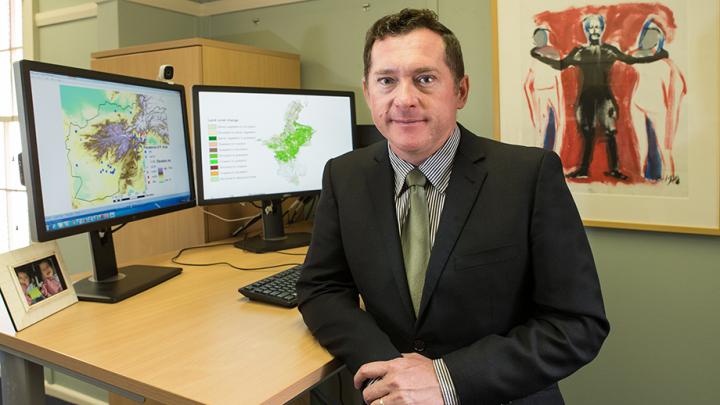Tracking parasites with satellites

This is Professor Archie Clements, Director at the ANU Research School of Population Health. Credit: Stuart Hay, ANU
Project leader Professor Archie Clements, from The Australian National University, said the research could help authorities in developing countries fight parasitic diseases.
“Some diseases are highly sensitive to their environment, especially parasitic diseases. With remote sensing you can identify places where disease flourishes,” said Professor Clements, Director of the ANU Research School of Population Health.
“This information is useful for decision makers to help them ensure scarce resources are targeted to where they are most needed.”
Parasitic diseases affect hundreds of millions of people every year, many of them in the least developed parts of the world.
The team uses satellite data such as temperature, rainfall, vegetation and land usage, and combines it with health data in a geographical information system (GIS).
The approach combines the skills of many scientists, such as entomologists, epidemiologists, software developers, social scientists and health policy specialists.
“The result is maps that are accessible to countries with limited capacity for managing disease data, tailored to their local needs.”
The team has trialed systems for malaria in Bhutan, Vanuatu and the Solomon Islands and is now seeking support to scale up to larger countries. Additionally, spatial predictions for other diseases such as worms and hydatids are being developed for China, the Philippines and other countries in the Asia-Pacific region.
“By taking this research the next step, we have the opportunity to have a meaningful impact on the real world, and save a lot of lives,” Professor Clements said.
Professor Clements is laying out a plan for the future of these systems at a symposium at the American Association for the Advancement of Science Conference, in San Jose, California this weekend.
Media Contact
All latest news from the category: Health and Medicine
This subject area encompasses research and studies in the field of human medicine.
Among the wide-ranging list of topics covered here are anesthesiology, anatomy, surgery, human genetics, hygiene and environmental medicine, internal medicine, neurology, pharmacology, physiology, urology and dental medicine.
Newest articles

Compact LCOS Microdisplay with Fast CMOS Backplane
…for High-Speed Light Modulation. Researchers from the Fraunhofer Institute for Photonic Microsystems IPMS, in collaboration with HOLOEYE Photonics AG, have developed a compact LCOS microdisplay with high refresh rates that…

New perspectives for material detection
CRC MARIE enters third funding period: A major success for terahertz research: Scientists at the University of Duisburg-Essen and the Ruhr University Bochum have been researching mobile material detection since…

CD Laboratory at TU Graz Researches New Semiconductor Materials
Using energy- and resource-saving methods, a research team at the Institute of Inorganic Chemistry at TU Graz aims to produce high-quality doped silicon layers for the electronics and solar industries….



